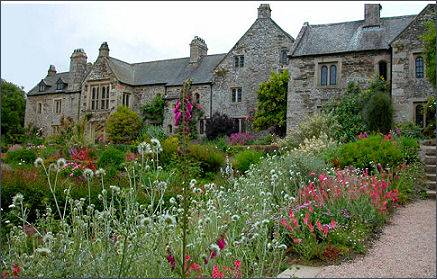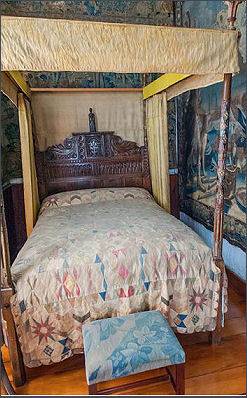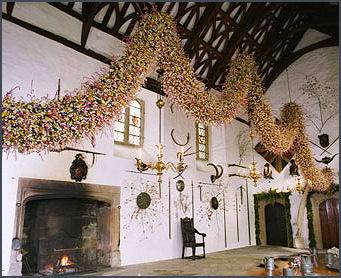Cotehele
OS Grid ref:- SX 422685
 Cotehele, a mediaeval/Tudor house in a picturesque riverside location, is situated at Calstock on Cornwall's border with Devon.
Cotehele, a mediaeval/Tudor house in a picturesque riverside location, is situated at Calstock on Cornwall's border with Devon.
The house was the home to the Edgecumbes, one of Cornwall's most influential families, for almost 600 years. The family acquired Cotehele through the marriage of William Edgcumbe to Hilaria de Cotehele, heiress to her brother's estates, in 1353. The original house was a quadrangular building of red sandstone, which still forms the lowest levels of walls surrounding the inner courtyard.
 The present building was begun in 1490 by Sir Richard Edgecumbe, the building was completed by his son to in 1520. Succeeding generations of the family did not alter the structure of the building, and today Cotehele is one of the most complete medieval manors in England. The house retains such a link to its past that even today it does not have electricity.
The present building was begun in 1490 by Sir Richard Edgecumbe, the building was completed by his son to in 1520. Succeeding generations of the family did not alter the structure of the building, and today Cotehele is one of the most complete medieval manors in England. The house retains such a link to its past that even today it does not have electricity.
Cotehele remained the Edgecumbe family seat until the seventeenth century, when they took up residence at Mount Edgecumbe, but the house stayed in the family until, in 1947, it was donated to the National Trust in 1947. The last Edgecumbe owner of Cotehele was Kenelm, 6th Earl of Mount Edgcumbe, whose son and heir, Piers, was killed in action near Dunkirk in 1940. The Earl considered Cotehele a memorial to his son, whose sword is on display in the chapel beneath a plaque in his honour.
The house is consists of medieval rooms built around two courtyards; a formal Hall Court and a Retainers Court. Off the Hall Court stands the imposing medieval Great Hall, with large windows overlooking the main court, the great hall boasts a superb timber ceiling, heraldic glass in the windows, and an interesting collection of arms and armour. Beyond the hall is a private chapel and dining room, again hung which is hung with tapestries.
The late medieval core of the building gives way to a seventeenth century tower, which contains 3 bedrooms. The White Room has an intricate four-poster bed hung with Georgian crewel-work. King Charles I is reputed to have slept in the King's Room while George III and his queen, Charlotte of Mecklenurg-Strelitz visited the house in 1789, the cushions they sat on are still reverently preserved. Cotehele is home to a rare collection of Tudor and Stuart furniture and English and Flemish tapestries, the fascinating collection of tapestries hang in all the main rooms. Most of these date from the seventeenth century and depict a wide range of subjects from daily pastimes to Roman myths.
 The house is set in an extensive estate, which offers riverside walks. The terraced formal gardens feature a domed medieval dovecote and a Valley Garden with a medieval stewpond. A 20 minute walk brings the visitor to a working corn mill, and a fifteenth century chapel.which contains the oldest working domestic clock in England, constructed before the invention off the pendulum, the clockface is regulated by the horizontal balance known as foliot. The triangular Prospect Tower, an eighteenth century folly offers excellent views over the surrounding countryside. The Mother Orchard features old-fashioned varieties of fruit traditionally grown in the Tamar area.
The house is set in an extensive estate, which offers riverside walks. The terraced formal gardens feature a domed medieval dovecote and a Valley Garden with a medieval stewpond. A 20 minute walk brings the visitor to a working corn mill, and a fifteenth century chapel.which contains the oldest working domestic clock in England, constructed before the invention off the pendulum, the clockface is regulated by the horizontal balance known as foliot. The triangular Prospect Tower, an eighteenth century folly offers excellent views over the surrounding countryside. The Mother Orchard features old-fashioned varieties of fruit traditionally grown in the Tamar area.
From the gardens a trail leads downhill through the Valley Garden and on into woodland to the Chapel in the Woods, constructed by Sir Richard Edgecumbe, the founder of Cotehele. The chapel commemorates an extraordinary escape which occured in 1483 when after rumours circulated that Richard III had murdered the 'Princes in the Tower,' the two sons of Edward IV, Sir Richard rose in rebellion against the king in favour of the Lancastrian Earl of Richmond (the future Henry VII). His rebellion was unsuccessful, Sir Henry Bodrugan, acting for the King, besieged him at Cotehele and he was forced to flee, pursued by Bodrugan's men him through the woods below Cotehele. The cornered Sir Richard tossed his hat into the gorge below, and his pursuers were fooled into assuming he had fallen into the river and drowned and abandoned the hunt. When Richard III was defeated at Bosworth, Sir Richard Edgcumbe was knighted on the battlefield by the victorious Henry Tudor and was appointed Comptroller of the King's Household. Sir Richard later built the small chapel on the spot to give thanks for his fortuitous escape.
A path past the chapel leads to the Quay, where the Cotehele Quay Discovery Centre is situated, a free museum built with the aid of the National Maritime Museum. The Shamrock, a traditional Tamar sailing barge launched in 1899 is moored at the Quayside . The Shamrock was used to carry manure, coal, limestone, sand and fertiliser up and down the river. Nearby, stretched out along the quayside, are ancient lime kilns beside the Edgcumbe Arms inn.